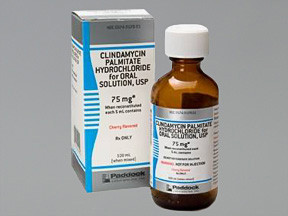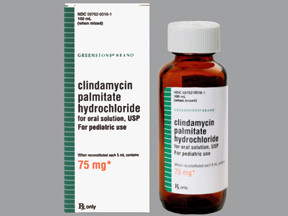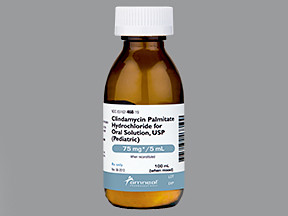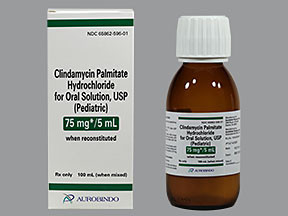CLINDAMYCIN LIQUID - ORAL
PHONETIC PRONUNCIATION: (KLIN-da-MYE-sin)
COMMON BRAND NAME(S): Cleocin
GENERIC NAME(S): clindamycin palmitate HCl
Uses
USES: Clindamycin is used to treat a wide variety of serious bacterial infections. It is an antibiotic that works by stopping the growth of bacteria. This antibiotic only treats bacterial infections. It will not work for viral infections (e.g., common cold, flu). Unnecessary use or overuse of any antibiotic can lead to its decreased effectiveness.
How to use CLINDAMYCIN LIQUID - ORAL
HOW TO USE: Shake the bottle well before each dose. Carefully measure the dose using a special measuring device/spoon. Do not use a household spoon because you may not get the correct dose. Take this medication by mouth with or without food as directed by your doctor, usually 3 or 4 times a day. For the best effect, take this antibiotic at evenly spaced times. To help you remember, take this medication at the same time(s) every day. Continue to take this medication until the full-prescribed amount is finished even if symptoms disappear after a few days. Stopping this medication too early may allow bacteria to continue to grow, which may result in a relapse of the infection. Inform your doctor if your condition persists or worsens.
Side Effects
Precautions
Interactions
Overdose
Images
Reviews
Faq for CLINDAMYCIN LIQUID - ORAL
Clindamycin liquid is an antibiotic medication that is taken orally. It is used to treat various bacterial infections, including dental infections, respiratory tract infections, skin infections, and bone and joint infections.
You should take clindamycin liquid exactly as prescribed by your doctor. It is usually taken by mouth every six to eight hours, with or without food. Be sure to shake the suspension well before each use and use the provided measuring spoon or cup to ensure the correct dosage.
If you miss a dose of clindamycin liquid, take it as soon as you remember. However, if it is close to the time for your next dose, skip the missed dose and resume your regular dosing schedule. Do not double the dose to make up for a missed one.
Common side effects of clindamycin liquid may include diarrhea, nausea, vomiting, stomach pain, and skin rash. If these side effects persist or worsen, contact your doctor.
It is important to inform your doctor about any known allergies, medical conditions, or current medications you are taking before starting clindamycin liquid. This medication may interact with other drugs, so it is crucial to disclose all information to your healthcare provider.
It is generally recommended to avoid consuming alcohol while taking clindamycin liquid, as it may increase the risk of certain side effects such as upset stomach or liver problems.
The effectiveness of clindamycin liquid varies depending on the individual and the type of infection being treated. It is important to continue taking the medication as prescribed, even if you start feeling better, in order to completely eliminate the infection.
It is important to consult with your doctor if you are pregnant or breastfeeding before using clindamycin liquid. They will weigh the potential risks and benefits and determine whether it is safe to use in your specific situation.
Clindamycin liquid can be prescribed for children, but the dosage will depend on their age, weight, and the specific condition being treated. It is important to follow the doctor's instructions and never exceed the recommended dosage for children.
Warning
WARNING: This medication should be used only for serious bacterial infections because it can sometimes cause a severe (rarely fatal) intestinal condition (Clostridium difficile-associated diarrhea) due to a resistant bacteria. This condition may occur during treatment or even weeks after treatment has stopped. Tell your doctor right away if you develop persistent diarrhea, abdominal or stomach pain/cramping, or blood/mucus in your stool. Do not use anti-diarrhea products or narcotic pain medications if you have these symptoms because these products may make them worse. Consult your doctor or pharmacist for details and an appropriate treatment plan.
Disclaimer
IMPORTANT: HOW TO USE THIS INFORMATION: This is a summary and does NOT have all possible information about this product. This information does not assure that this product is safe, effective, or appropriate for you. This information is not individual medical advice and does not substitute for the advice of your health care professional. Always ask your health care professional for complete information about this product and your specific health needs.






No Reviews Yet